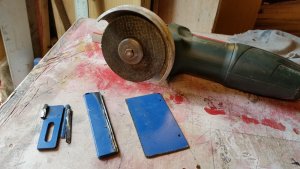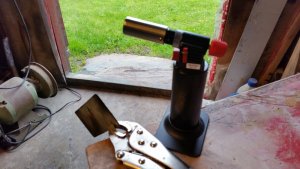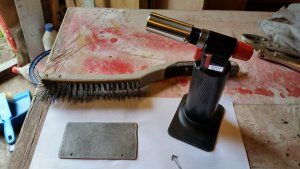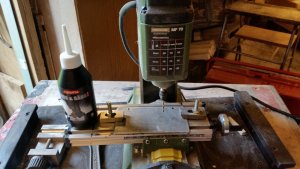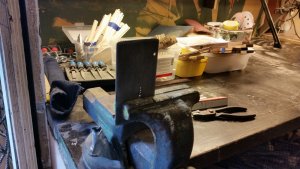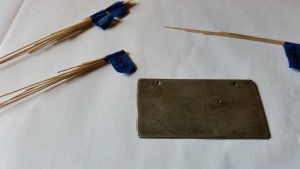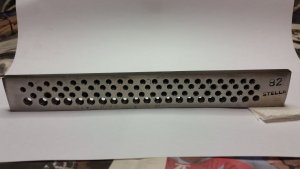-

Win a Free Custom Engraved Brass Coin!!!
As a way to introduce our brass coins to the community, we will raffle off a free coin during the month of August. Follow link ABOVE for instructions for entering.
You are using an out of date browser. It may not display this or other websites correctly.
You should upgrade or use an alternative browser.
You should upgrade or use an alternative browser.
Your drawplate from model expo looks like one meant for wire Knut.Wire and wood drawplates work completely differently.Wire is passed through the wide side and reduces in diameter and stretches at the same time.No material is removed.On wood drawplates,the wood goes through the narrow side and material is sliced off.
Kind Regards
Nigel
Kind Regards
Nigel
Yes Knut,I have a Byrnes drawplate and the design is very different to the ones meant for wire.The ones for wire aren't designed with a cutting edge as such hence your poor results.
Regards
Nigel
Regards
Nigel
- Joined
- Dec 3, 2018
- Messages
- 2,451
- Points
- 538

Thanks Nigel, I possibly bought the wrong type of pull plate in rage because I didn't get to buy from Byrnes because I got big trouble with the payment when I try to bought from them. very annoying and expensive choice, possibly I have not read well about the product before I bought.
For a good while I used my self made drawplates. For this I just drilled holes into an iron plate. The protruding fin will provide the cutting edge so the dowel will have to be drawn into the hole in the same direction as the drill went into it while drilling the hole. Obviously the existence of the full set of drill series might be a problem as we have to provide hole series with decreasing diameters. And this fin-edge would not last long in the absence of a proper heat treatment. I still make draw plates occassionally for bigger diameters (my 'proper' drawplates biggest hole diameter is 2mm). For a rougher but quicker job we can use a battery operated drill, into the chuck of which the oversized dowel with a conical tip is tightened and then 'drilled' into the drawplate's hole.
Using self-made drill plates can only be a temporary solution. If we have to pruduce quantities of dowels in different diameters, the solution is to buy a proper drawplate which might not be cheap. Even budget-orientated purchases (ie. MicroMark or similar) might not be the right answer.
Janos
Using self-made drill plates can only be a temporary solution. If we have to pruduce quantities of dowels in different diameters, the solution is to buy a proper drawplate which might not be cheap. Even budget-orientated purchases (ie. MicroMark or similar) might not be the right answer.
Janos
Knut,
There is one more thing which you can try with the Model Expo plate. If you got a fine FLAT water or oil stone you can sharpen up the cutting edges of the holes with the stone by working on the side of the plate opposite to the side where the holes are filleted (provided that the holes have a square, sharp edge there at all). This might work if the material and the heat treatment of the plate is the proper stuff.
Janos
There is one more thing which you can try with the Model Expo plate. If you got a fine FLAT water or oil stone you can sharpen up the cutting edges of the holes with the stone by working on the side of the plate opposite to the side where the holes are filleted (provided that the holes have a square, sharp edge there at all). This might work if the material and the heat treatment of the plate is the proper stuff.
Janos
I might give this a try when I need a drawplate:
Items such as an old file or an old blade from a sawmill is made of high carbon steel (any kind of steel that will break rather than bend should work). Put the steel with some charcoal in the grill-starter and fire it up. I'll try to raise the temperature with air from my scuba diving tank. If you do not have a dive tank it can also be done using the admiral's hairdryer. The latter method is a bit dangerous though as it implies a risk of keelhauling or even DSB (deadly seemen buildup). Raise the temperature to the steel becomes evenly red (and none magnetic). Keep it at that temperature for a few minutes and then quickly return the hair dryer before the admiral finds out. Let the coal burn out and the whole thing slowly cool down. That should anneal the steel and make it possible to drill all the holes and mirror polish one of the faces with e.g. water grinding paper to make sharp edges.
Having done that sneak into the galley, steal a bottle of sun flower oil, or similar, and pour it into the admiral's chamberpot. Fire up the grill-starter with the steel and charcoal and raise the temperature so the steel becomes evenly red for a few minutes. Then as quicly as possible transfer the steel from the grill-starter to the admiral's chamberpot and stir it around in the oil to cool it quicly.
Items such as an old file or an old blade from a sawmill is made of high carbon steel (any kind of steel that will break rather than bend should work). Put the steel with some charcoal in the grill-starter and fire it up. I'll try to raise the temperature with air from my scuba diving tank. If you do not have a dive tank it can also be done using the admiral's hairdryer. The latter method is a bit dangerous though as it implies a risk of keelhauling or even DSB (deadly seemen buildup). Raise the temperature to the steel becomes evenly red (and none magnetic). Keep it at that temperature for a few minutes and then quickly return the hair dryer before the admiral finds out. Let the coal burn out and the whole thing slowly cool down. That should anneal the steel and make it possible to drill all the holes and mirror polish one of the faces with e.g. water grinding paper to make sharp edges.
Having done that sneak into the galley, steal a bottle of sun flower oil, or similar, and pour it into the admiral's chamberpot. Fire up the grill-starter with the steel and charcoal and raise the temperature so the steel becomes evenly red for a few minutes. Then as quicly as possible transfer the steel from the grill-starter to the admiral's chamberpot and stir it around in the oil to cool it quicly.
Hmmmm. I had one of these. I don't know where I bought it, but, I was never able to make it work. I can't find it now, so I probably tossed it out.
I was probably not using it correctly, or, it was a cheap one. Seems to me it had a bow in it too, so it didn't lay flat (Signs of cheapness maybe?).
According to the instructions on the MicroMark catalog one, sizing wood should be done from the "back" (the side with the sharp edges around the hole). Resizing malleable wire is done from the front (the tapered side). That's probably what I was doing wrong.
That said, I've seen draw plates at the jewelers that are specifically for wire and the holes are tapered on both sides, more so on the front than the back.
I would think ones for wood would be tapered on just one side?
EJ
I was probably not using it correctly, or, it was a cheap one. Seems to me it had a bow in it too, so it didn't lay flat (Signs of cheapness maybe?).
According to the instructions on the MicroMark catalog one, sizing wood should be done from the "back" (the side with the sharp edges around the hole). Resizing malleable wire is done from the front (the tapered side). That's probably what I was doing wrong.
That said, I've seen draw plates at the jewelers that are specifically for wire and the holes are tapered on both sides, more so on the front than the back.
I would think ones for wood would be tapered on just one side?
EJ
I have used the "cheap" (relative) plate for many years - successfully with toothpicks in an electric drill. However, wanting sizes under 0.6 mm, bought a Brynes. beautifully made and very effective.( Just need lots more extra small drill bits. )It all depends on the scale of the build and level of obsession.
- Joined
- Dec 3, 2018
- Messages
- 2,451
- Points
- 538

Thank you for your interested friends, I have given up this project and purchased a Byrnes drawing plate. I have used birch toothpicks in the meantime.
Byrnes drawing plate, I have not so much experience with yet, but everyone else who has it is very happy, irritatingly difficult to order.
Byrnes drawing plate, I have not so much experience with yet, but everyone else who has it is very happy, irritatingly difficult to order.
ok, not electrical wire, wire round stock, never saw before.
 contenti.com
contenti.com
Draw Plates | Contenti
Hardened steel draw plates for reducing wire stock diameter. Also wood and plastic drawplates.
No way we are saying those are junk! They are not suitable to draw wood thru. Let's talk... What is drawplate and why they are in use? A drawplate is type of die consisting of a hardened steel plate with one or more holes through which wire is drawn to make it thinner. Historically, and still, jewelers used drawplates to reduce the thickness of wire by reshaping the metal, increasing length while decreasing diameter. As such, a piece of wire will become considerably lengthened during the drawing process. The plate has rows of holes drilled through it which are slightly wider at the back (entry points).’ve always meant to pick up a draw plate fir wood, so you guys are saying the ones at model expo and micro mark are junk? Anyone have a link for one that’s good?
The tapered wire end is inserted into a hole with a final diameter just smaller than its current width and pulled thru the hole.
For our purpose, we use opposite side of the drawplate to pull the wood. In our case, we are making wood stick thinner by removing wood. The hole surface must be razor sharp to remove wood.
Most drawplates design only to pull wire, they are not suitable for the wood. Long time back we found a really good drawplate for our needs, it is a drawplate from Byrnes machines. With such tool, you will be able to make treenails 0.6mm
Byrnes Model Machines - Drawplate
Byrnes Model Machines produces precision-engineered miniature Table Saws and Thickness Sanders for Ship Modelers, Dollhouse Makers and Model Railroad Builders; every machine has an accuracy measured in thousandths of an inch.
www.byrnesmodelmachines.com

